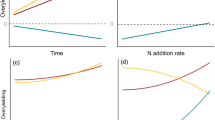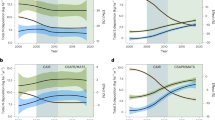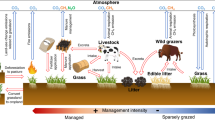Abstract
The negative effect of increasing atmospheric nitrogen (N) pollution on grassland biodiversity is now incontrovertible1,2,3. However, the recent introduction of cleaner technologies in the UK has led to reductions in the emissions of nitrogen oxides, with concomitant decreases in N deposition4. The degree to which grassland biodiversity can be expected to ‘bounce back’ in response to these improvements in air quality is uncertain, with a suggestion that long-term chronic N addition may lead to an alternative low biodiversity state5. Here we present evidence from the 160-year-old Park Grass Experiment at Rothamsted Research, UK6, that shows a positive response of biodiversity to reducing N addition from either atmospheric pollution or fertilizers. The proportion of legumes, species richness and diversity increased across the experiment between 1991 and 2012 as both wet and dry N deposition declined. Plots that stopped receiving inorganic N fertilizer in 1989 recovered much of the diversity that had been lost, especially if limed. There was no evidence that chronic N addition has resulted in an alternative low biodiversity state on the Park Grass plots, except where there has been extreme acidification, although it is likely that the recovery of plant communities has been facilitated by the twice-yearly mowing and removal of biomass. This may also explain why a comparable response of plant communities to reduced N inputs has yet to be observed in the wider landscape.
This is a preview of subscription content, access via your institution
Access options
Subscribe to this journal
Receive 51 print issues and online access
$199.00 per year
only $3.90 per issue
Buy this article
- Purchase on Springer Link
- Instant access to full article PDF
Prices may be subject to local taxes which are calculated during checkout




Similar content being viewed by others
References
Clark, C. M. & Tilman, D. Loss of plant species after chronic low-level nitrogen deposition to prairie grasslands. Nature 451, 712–715 (2008)
Duprã, C. et al. Changes in species richness and composition in European acidic grasslands over the past 70 years: the contribution of cumulative atmospheric nitrogen deposition. Glob. Change Biol. 16, 344–357 (2010)
Stevens, C. J. et al. Nitrogen deposition threatens species richness of grasslands across Europe. Environ. Pollut. 158, 2940–2945 (2010)
Goulding, K. W. T. et al. Nitrogen deposition and its contribution to nitrogen cycling and associated soil processes. New Phytol. 139, 49–58 (1998)
Isbell, F., Tilman, D., Polasky, S., Binder, S. & Hawthorne, P. Low biodiversity state persists two decades after cessation of nutrient enrichment. Ecol. Lett. 16, 454–460 (2013)
Silvertown, J. et al. The Park Grass Experiment 1856–2006: Its contribution to ecology. J. Ecol. 94, 801–814 (2006)
Fowler, D. et al. A chronology of nitrogen deposition in the UK between 1900 and 2000. Water Air Soil Pollut. Focus 4, 9–23 (2004)
Stevens, C. J., Dise, N. B., Mountford, J. O. & Gowing, D. J. Impact of nitrogen deposition on the species richness of grasslands. Science 303, 1876–1879 (2004)
RoTAP. Review of Transboundary Air Pollution: Acidification, Eutrophication, Ground Level Ozone and Heavy Metals in the UK. Contract Report to the UK Government; http://www.rotap.ceh.ac.uk/ (Centre for Ecology and Hydrology, 2012)
Zhao, F. J., Knights, J. S., Hu, Z. Y. & McGrath, S. P. Stable sulfur isotope ratio indicates long-term changes in sulfur deposition in the broadbalk experiment since 1845. J. Environ. Qual. 32, 33–39 (2003)
Blake, L., Goulding, K. W. T., Mott, C. J. B. & Johnston, A. E. Changes in soil chemistry accompanying acidification over more than 100 years under woodland and grass at Rothamsted Experimental Station, UK. Eur. J. Soil Sci. 50, 401–412 (1999)
Smart, S. M. et al. Clarity or confusion? Problems in attributing large-scale ecological changes to anthropogenic drivers. Ecol. Indic. 20, 51–56 (2012)
Maskell, L. C., Smart, S. M., Bullock, J. M., Thompson, K. & Stevens, C. J. Nitrogen deposition causes widespread loss of species richness in British habitats. Glob. Change Biol. 16, 671–679 (2010)
van den Berg, L. J. L. et al. Direct and indirect effects of nitrogen deposition on species composition change in calcareous grasslands. Glob. Change Biol. 17, 1871–1883 (2011)
Power, S. A., Green, E. R., Barker, C. G., Bell, J. N. B. & Ashmore, M. R. Ecosystem recovery: heathland response to a reduction in nitrogen deposition. Glob. Change Biol. 12, 1241–1252 (2006)
Terry, A. C., Ashmore, M. R., Power, S. A., Allchin, E. A. & Heil, G. W. Modelling the impacts of atmospheric nitrogen deposition on Calluna-dominated ecosystems in the UK. J. Appl. Ecol. 41, 897–909 (2004)
Clark, C. M. & Tilman, D. Recovery of plant diversity following N cessation: effects of recruitment, litter, and elevated N cycling. Ecology 91, 3620–3630 (2010)
Dodd, M. E., Silvertown, J., McConway, K., Potts, J. & Crawley, M. Application of the British National Vegetation Classification to the communities of the Park Grass Experiment through time. Folia Geobot. Phytotaxon. 29, 321–334 (1994)
Williams, E. D. Botanical Composition of the Park Grass Plots; Rothamsted Experimental Station Report for 1977, part 2, 31–36 (Lawes Agricultural Trust, 1978)
Goulding, K. W. T., Poulton, P. R., Thomas, V. H. & Williams, R. J. B. Atmospheric deposition at Rothamsted Experimental Station, Saxmundham Experimental Station and Woburn Experimental Station, England, 1969–1984. Wat. Air Soil Pollut. 29, 27–49 (1986)
Hall, D. J. The Precipitation Collector for use in the Secondary National Acid Deposition Network (Warren Spring Laboratory, 1986)
Smith, R. I., Fowler, D., Sutton, M. A., Flechard, C. & Coyle, M. Regional estimation of pollutant gas dry deposition in the UK: model description, sensitivity analyses and outputs. Atmos. Environ. 34, 3757–3777 (2000)
Silvertown, J., Dodd, M. E., McConway, K., Potts, J. & Crawley, M. Rainfall, biomass variation, and community composition in the Park Grass Experiment. Ecology 75, 2430–2437 (1994)
Crawley, M. J. et al. Determinants of species richness in the park grass experiment. Am. Nat. 165, 179–192 (2005)
Payne, R. W., Murray, D. A. & Harding, S. A. An Introduction to the GenStat Command Language 14 edn (VSN International, 2011)
Smilauer, P. & Leps, J. Multivariate Analysis of Ecological Data Using Canoco 5 (Cambridge Univ. Press, 2014)
Acknowledgements
We thank the large teams of people who were involved in the vegetation sampling and sorting between 1991 and 2012, and J. Lepš and P. Šmilauer for their advice on the multivariate analysis. Park Grass is supported by the UK Biotechnology and Biological Sciences Research Council (BBSRC) and the Lawes Agricultural Trust. The wet N deposition (precipitation chemistry) data set for 1992–2013 was provided courtesy of the UK Environmental Change Network (ECN). I.H.K. was supported by Deutsche Forschungsgemeinschaft (DFG SCHN 557/5-1).
Author information
Authors and Affiliations
Contributions
J.S., M.J.C. A.J.M., P.R.P. and T.S. co-ordinated and contributed to the vegetation sampling between 1991 and 2012. T.S. and K.W.T.G. were responsible for collecting and analysing nitrogen deposition data. I.H.K. and H.S. analysed nitrogen limitation of vegetation. J.S. was responsible for the statistical analysis and initial draft of the paper. All authors contributed to the final version.
Corresponding author
Ethics declarations
Competing interests
The authors declare no competing financial interests.
Extended data figures and tables
Extended Data Figure 1 The Bray–Curtis dissimilarity index.
a–h, The response of Bray–Curtis dissimilarity for all sub-plots on plot 9 (a–d) and plot 14 (e–h). Community data from 1992–2012 have been compared to samples taken in 1991 for the transition plots (filled circles) and plots that continue to receive inorganic N fertilizer (open circles). Lines indicate a significant fit for a rectangular hyperbola function; where separate lines have been fitted in a single panel, a significant difference in the asymptote of the responses was observed.
Extended Data Figure 2 Change in time over the recent sampling period (1991–2012) of species richness, eH′, and percentage legumes in the first herbage cut.
a–i, Plot 3 (a, d, g), plot 9 (filled circles, 9/1; open circles, 9/2) (b, e, h) and plot 14 (filled circles, 14/1; open circles, 14/2) (c, f, i). The averages of sub-plots a, b and c are presented; sub-plot d was excluded to avoid the confounding effect of very low pH on plot 9/1d allowing a direct comparison between treatments at the main plot level.
Extended Data Figure 3 Comparison of the effect of decreasing atmospheric N inputs and the cessation of N fertilization on plant communities.
a, Partial canonical correspondence analysis (CCA) of the effect of withholding nitrogen fertilizer on plant communities on the transition plots 9/1 and 14/1 compared to the plots that continued to receive N, 9/2 and 14/2. Data from all sub-plots during the modern day sampling period (1991–2012) were used, and year was included as a categorical covariate. b, Partial CCA of the temporal response of plant communities on all sub-plots sampled during the modern day period, 1991–2012, excluding the transition plots 9/1 and 14/1, with year entered as a continuous variable and plot as a covariate. In both ordination plots, species were only included if they were in the top 20 species ranked by their weighting in the CCA and had a P value indicating their association with the constrained axis of <0.1. Agrca, Agrostis capillaris; Alopr, Alopecurus pratensis; Antsy, Anthriscus sylvestris; Arrel, Arrhenatherum elatius; Conma, Conopodium majus; Dacgl, Dactylis glomerata; Hersp, Heracleum sphondylium; Latpr, Lathyrus pratensis; Plala, Plantago lanceolata; Poapr, Poa pratensis; Poatr, Poa trivialis; Ranac, Racunculus acris; Rumac, Rumex acetosa; Trapr, Tragopogon pratense; Tripr, Trifolium pratense.
Source data
Rights and permissions
About this article
Cite this article
Storkey, J., Macdonald, A., Poulton, P. et al. Grassland biodiversity bounces back from long-term nitrogen addition. Nature 528, 401–404 (2015). https://doi.org/10.1038/nature16444
Received:
Accepted:
Published:
Issue Date:
DOI: https://doi.org/10.1038/nature16444
This article is cited by
-
Effects of C and N application on Azotobacter and nitrogen cycle in farmland soils of central Guizhou, China
Chemical and Biological Technologies in Agriculture (2023)
-
Long-term trends in yield variance of temperate managed grassland
Agronomy for Sustainable Development (2023)
-
Estimating dark diversity and regional species pool in the high-altitude Himalayan habitats
Biodiversity and Conservation (2023)
-
Mowing increased plant diversity but not soil microbial biomass under N-enriched environment in a temperate grassland
Plant and Soil (2023)
-
Changes in organic carbon to clay ratios in different soils and land uses in England and Wales over time
Scientific Reports (2022)
Comments
By submitting a comment you agree to abide by our Terms and Community Guidelines. If you find something abusive or that does not comply with our terms or guidelines please flag it as inappropriate.



